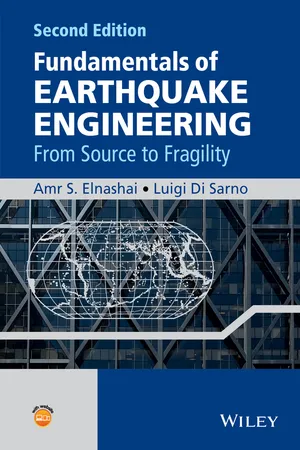
Fundamentals of Earthquake Engineering
From Source to Fragility
- English
- ePUB (mobile friendly)
- Available on iOS & Android
About This Book
Fundamentals of Earthquake Engineering: From Source to Fragility, Second Edition combines aspects of engineering seismology, structural and geotechnical earthquake engineering to assemble the vital components required for a deep understanding of response of structures to earthquake ground motion, from the seismic source to the evaluation of actions and deformation required for design, and culminating with probabilistic fragility analysis that applies to individual as well as groups of buildings. Basic concepts for accounting for the effects of soil-structure interaction effects in seismic design and assessment are also provided in this second edition.
The nature of earthquake risk assessment is inherently multi-disciplinary. Whereas this book addresses only structural safety assessment and design, the problem is cast in its appropriate context by relating structural damage states to societal consequences and expectations, through the fundamental response quantities of stiffness, strength and ductility.
This new edition includes material on the nature of earthquake sources and mechanisms, various methods for the characterization of earthquake input motion, effects of soil-structure interaction, damage observed in reconnaissance missions, modeling of structures for the purposes of response simulation, definition of performance limit states, fragility relationships derivation, features and effects of underlying soil, structural and architectural systems for optimal seismic response, and action and deformation quantities suitable for design.
Key features:
- Unified and novel approach: from source to fragility
- Clear conceptual framework for structural response analysis, earthquake input characterization, modelling of soil-structure interaction and derivation of fragility functions
- Theory and relevant practical applications are merged within each chapter
- Contains a new chapter on the derivation of fragility
- Accompanied by a website containing illustrative slides, problems with solutions and worked-through examples
Fundamentals of Earthquake Engineering: From Source to Fragility, Second Edition is designed to support graduate teaching and learning, introduce practising structural and geotechnical engineers to earthquake analysis and design problems, as well as being a reference book for further studies.
Frequently asked questions
Information
1
Earthquake Characteristics
1.1 Causes of Earthquakes
1.1.1 Plate Tectonics Theory


Table of contents
- Cover
- Title page
- Table of Contents
- Preface
- Foreword
- Acknowledgements
- Introduction
- List of Abbreviations
- List of Symbols
- 1 Earthquake Characteristics
- 2 Response of Structures
- 3 Earthquake Input Motion
- 4 Response Evaluation
- 5 Fragility Relationships for Structures
- 6 Seismic Soil–Structure Interaction
- Concluding Remarks
- Appendix A
- Appendix B
- Index
- End User License Agreement